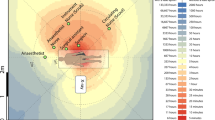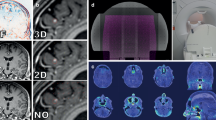Abstract
The purpose of this study was to parametrize the in-air one sigma spot size for various energies and air gaps in pencil beam scanning (PBS) proton therapy. The current study included range shifters with a water equivalent thickness (WET) of 40 mm (RS40) and 75 mm (RS75). For RS40, the spot sizes were measured for energies ranging from 80 to 225 MeV in increments of 2.5 MeV, whereas the air gap was varied from 5 to 25 cm in increments of 2.5 cm. For RS75, the spot sizes were measured for energies ranging from 120 to 225 MeV in increments of 2.5 MeV, whereas the air gap was varied from 5 to 35 cm in increments of 2.5 cm. For both RS40 and RS75, all measurements (n = 1090) were acquired at the isocenter using a Lynx 2D scintillation detector. For RS40, the spot sizes increased from 3.1 mm to 10.4 mm, whereas the variation in spot sizes for RS75 ranged from 3.3 mm to 13.1 mm. For each range shifter, an analytical equation demonstrating the relationship of the spot size with the proton energy and air gap was obtained. The best parametrization results were obtained with the 3rd degree polynomial fits of the energy and air gap parameters. The average difference between the modeled and measured spot sizes was 0.0 ± 0.1 mm (range, − 0.24–0.21 mm) for RS40, and 0.0 ± 0.1 mm (range, − 0.23–0.15 mm) for RS75. In conclusion, the analytical model agrees within ± 0.25 mm of the measured spot sizes on a ProteusPLUS PBS proton system with a PBS dedicated nozzle.




Similar content being viewed by others
References
Schreuder AN, Shamblin J. Proton therapy delivery: what is needed in the next ten years? Br J Radiol. 2019;14:20190359.
Lin L, Ainsley CG, Solberg TD, McDonough JE. Experimental characterization of two-dimensional spot profiles for two proton pencil beam scanning nozzles. Phys Med Biol. 2014;59(2):493–504.
Rana S, Samuel EJJ. Measurements of in-air spot size of pencil proton beam for various air gaps in conjunction with a range shifter on a ProteusPLUS PBS dedicated machine and comparison to the proton dose calculation algorithms. Australas Phys Eng Sci Med. 2019;42(3):853–62.
Moteabbed M, Yock TI, Depauw N, Madden TM, Kooy HM, Paganetti H. Impact of spot size and beam-shaping devices on the treatment plan quality for pencil beam scanning proton therapy. Int J Radiat Oncol Biol Phys. 2016;95(1):190–8.
Both S, Shen J, Kirk M, et al. Development and clinical implementation of a universal bolus to maintain spot size during delivery of base of skull pencil beam scanning proton therapy. Int J Radiat Oncol Biol Phys. 2014;90(1):79–84.
Titt U, Mirkovic D, Sawakuchi GO, et al. Adjustment of the lateral and longitudinal size of scanned proton beam spots using a pre-absorber to optimize penumbrae and delivery efficiency. Phys Med Biol. 2010;55(23):7097–106.
Pedroni E, Scheib S, Böhringer T, et al. Experimental characterization and physical modelling of the dose distribution of scanned proton pencil beams. Phys Med Biol. 2005;50(3):541–61.
Shamurailatpam DS, Manikandan A, Ganapathy K, Noufal MP, Patro KC, Rajesh T, Jalali R. Characterization and performance evaluation of the first-proton therapy facility in India. J Med Phys. 2020;45:59–655.
Rana S, Bennouna J, Samuel EJJ, Gutierrez AN. Development and long-term stability of a comprehensive daily QA program for a modern pencil beam scanning (PBS) proton therapy delivery system. J Appl Clin Med Phys. 2019;20(4):29–44.
Liang X, Li Z, Zheng D, Bradley JA, Rutenberg M, Mendenhall N. A comprehensive dosimetric study of Monte Carlo and pencil-beam algorithms on intensity-modulated proton therapy for breast cancer. J Appl Clin Med Phys. 2019;20:128–36.
Rana S, Greco K, Samuel EJJ, Bennouna J. Radiobiological and dosimetric impact of RayStation pencil beam and Monte Carlo algorithms on intensity-modulated proton therapy breast cancer plans. J Appl Clin Med Phys. 2019;20(8):36–46.
Tommasino F, Fellin F, Lorentini S, Farace P. Impact of dose engine algorithm in pencil beam scanning proton therapy for breast cancer. Phys Med. 2018;50:7–12.
Rana S, Bennouna J. Impact of air gap on intensity-modulated proton therapy breast plans. J Med Imaging Radiat Sci. 2019;50(4):499–505.
Author information
Authors and Affiliations
Corresponding author
Ethics declarations
Conflict of interest
The authors have no conflicts of interest to declare.
Ethical approval
This article does not contain any studies performed with human participants or animals.
Additional information
Publisher's Note
Springer Nature remains neutral with regard to jurisdictional claims in published maps and institutional affiliations.
About this article
Cite this article
Rana, S., Rosenfeld, A.B. Parametrization of in-air spot size as a function of energy and air gap for the ProteusPLUS pencil beam scanning proton therapy system. Radiol Phys Technol 13, 392–397 (2020). https://doi.org/10.1007/s12194-020-00589-w
Received:
Revised:
Accepted:
Published:
Issue Date:
DOI: https://doi.org/10.1007/s12194-020-00589-w




